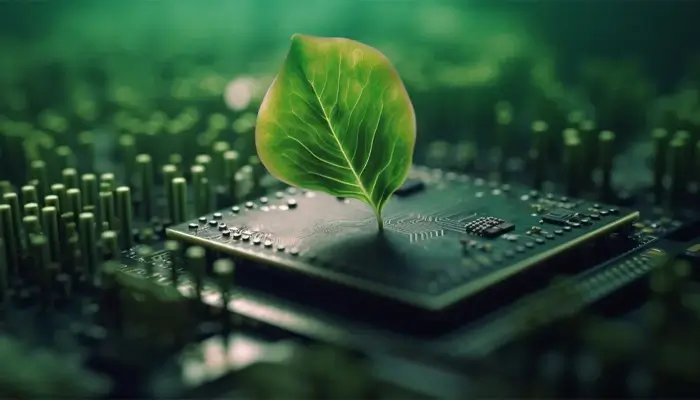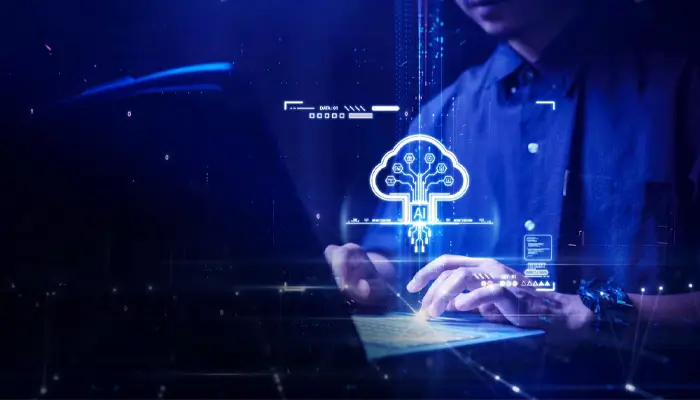
How Edge AI Is Powering Faster Websites and Smarter User Experiences
November 14, 2025
API-Driven Design: Why Modular Web Architecture Is the Future of Development
November 19, 2025Why the future of digital creativity depends on eco-conscious design, energy-efficient hosting and sustainable coding practices.
The internet might be invisible, but its carbon footprint isn’t.
Every email, image or website visit consumes energy. In fact, according to the Shift Project, the digital sector contributes nearly 4% of global CO₂ emissions, a number expected to double by 2030 if unchecked.
In 2025, a new movement is taking shape: Sustainable Tech Design.
Designers, developers and digital marketers are rethinking creativity through the lens of green computing, embracing energy efficiency, responsible design and environmentally conscious code.
Here’s how the creative world is getting greener, without sacrificing innovation.
-
The Rise of Green Computing in Digital Design
Green computing refers to the responsible use of computing resources with minimal environmental impact, from hardware to software.
In the context of digital design and web development, this means:
- Choosing energy-efficient hosting.
- Designing lighter, faster websites.
- Writing optimized, sustainable code.
Fact: The average webpage produces 0.8 grams of CO₂ per view. For a site with 100,000 monthly visits, that equals almost a ton of CO₂ yearly, the same as flying from London to New York and back.
Sustainable design isn’t just
ethical, it’s strategic. Faster, optimized sites not only reduce emissions but also improve SEO, accessibility and user experience.

-
Energy-Efficient Hosting: The Green Foundation
Your website’s environmental footprint starts with its hosting provider.
In 2025, green web hosts use renewable energy sources, carbon offsets and intelligent power management systems to reduce impact.
Top Sustainable Hosting Providers:
- Google Cloud Green Hosting: 100% renewable energy–powered, with carbon-intelligent computing that shifts tasks to regions using cleaner electricity.
- GreenGeeks: Offsets 3x the power it consumes through renewable energy credits.
- Kinsta & Cloudways: Leverage energy-optimized cloud networks via Google’s eco-friendly infrastructure.
Stat Insight: According to Statista 2025, switching to green hosting can cut a website’s carbon footprint by up to 70% compared to traditional providers.
For freelancers and agencies, it’s an easy yet impactful first step toward sustainable creativity.
-
Low-Impact Design: Creativity Meets Consciousness
Design trends in 2025 emphasize minimalism, optimization and clarity, not just for aesthetics, but sustainability.
Every image, animation or plugin adds to data weight and therefore, energy consumption.
Sustainable Design Principles:
- Compress visuals using modern formats (like WebP or AVIF).
- Use dark mode–friendly colours to reduce screen power on OLED devices.
- Limit auto-playing videos or heavy background motion.
- Embrace minimalist UI/UX to reduce loading complexity.
Example:
The BBC’s Eco Mode Initiative found that optimizing video formats and adaptive streaming reduced its data load by 20%, cutting streaming-related emissions significantly.
Less data = lower energy = smaller footprint.
-
Sustainable Code Practices: Clean Code, Clean Planet
Behind every green website is a clean, efficient codebase.
Sustainable coding practices include:
- Removing unused libraries and scripts.
- Using lightweight frameworks like Astro or Eleventy instead of bloated ones.
- Enabling lazy loading for images and scripts.
- Writing reusable, modular code to prevent redundancy.
Developers can also use the Website Carbon Calculator or Ecograder to measure and reduce their site’s impact.
Pro Tip: Minifying CSS, JS and HTML can reduce energy use by up to 30% by cutting unnecessary data transfers.
-
The Role of AI in Sustainable Creativity
AI isn’t just revolutionizing design; it’s also making it greener.
- Adobe Firefly optimizes asset generation using energy-efficient model training.
- Canva’s Smart Resize reduces duplication by automating adaptive designs.
- AI hosting systems like those used by Cloudflare and Google Cloud balance workloads to minimize server strain and emissions.
Even content management systems like WordPress now offer sustainability plugins that analyse website efficiency and carbon metrics.
Example:
AI-based predictive caching reduces unnecessary data requests, saving bandwidth and energy while improving load speeds.
-
Why Sustainable Design Is the Future of Branding
In 2025, consumers are choosing brands that care.
A study by NielsenIQ shows that 78% of global consumers prefer to engage with environmentally responsible companies.
For designers and marketers, this means sustainability is now a selling point.
Showcasing green credentials, such as carbon-neutral hosting or eco-friendly design, builds trust, loyalty and a competitive edge.
Case Example:
Agencies like Pentagram and Huge Inc. have started publishing sustainability impact reports, tracking digital carbon output per campaign. This transparency enhances credibility and brand value.
-
A Call to Creatives: Design with Purpose
The shift toward sustainable tech design isn’t a constraint, it’s an opportunity.
It challenges creatives to innovate within limits, balancing beauty with efficiency.
By combining eco-friendly hosting, optimized design and clean code, designers can reduce digital pollution while enhancing performance and brand integrity.
Remember: Every kilobyte saved, every optimized image, every efficient query, counts toward a cleaner digital future.
Conclusion
Sustainable tech design is redefining creativity in 2025, proving that innovation doesn’t have to come at the planet’s expense.
By embracing green hosting, low-impact design and sustainable code, creatives can craft digital experiences that are not only beautiful and fast but also environmentally responsible.
Because in the new era of digital design, the most powerful colour isn’t blue or red, it’s green.
If you have any questions regarding “AI Is Transforming Websites” feel free to contact us. For inquiries and consultations, call us at: +92 321 4808303 or Email us at: hello@owaisgilani.com.
Disclaimer: The information shared on this website is for educational and informational purposes only and reflects my personal views and experiences. While I strive to provide accurate and helpful content, readers should use their own judgment and consult with a qualified professional before making any decisions based on the information here. I am not responsible for any actions taken based on this content. Feel free to reach out to me if you need clarification or have questions before using any part of this information.



